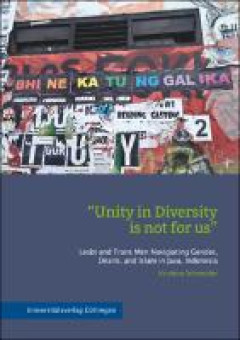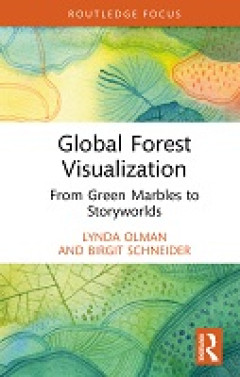Ditapis dengan
E-book The Original Portrayal of Mozart’s Don Giovanni
When Carl Maria von Weber conducted Mozart’s Don Giovanni in Dresden in the 1820s, one of the people sitting in the auditorium was the Italian singer Luigi Bassi who had created the title role back in 1787. And he was not pleased with what he saw. ‘Bassi generally passed the judgement on all Don Giovannis whom he and I saw performing’, his friend Count Hohenthal recalled a few years afte…
- Edisi
- -
- ISBN/ISSN
- 9780429281709
- Deskripsi Fisik
- 261 hlm
- Judul Seri
- -
- No. Panggil
- 782.1 SCH t

E-book "Unity in Diversity is Not For Us"
Unity in Diversity is not for us explores the lived experiences of primarily Muslim lesbians and trans men (LT+) in Indonesia, where Islam is the majority religion. Using an ethnographic approach, the book traces how LT+ individuals understand their identities and negotiate their gender and desire amidst socio-religious rejection. The analysis illustrates the biographical process of coming of a…
- Edisi
- -
- ISBN/ISSN
- 9783863956349
- Deskripsi Fisik
- 373 halaman
- Judul Seri
- -
- No. Panggil
- 300.72 SCH u
E-book Staging China : The Politics of Mass Spectacle
It is 2009, a year after the Beijing Olympics, and I have made my way across northern Beijing, past one of the massive ring-roads, to a large block of office buildings that sits not too far from the Olympic axis — a long stretch of asphalt, greenery, and event buildings that cuts across the city in an extension of the old north-south connection that the Forbidden Ci…
- Edisi
- -
- ISBN/ISSN
- 9789400603462
- Deskripsi Fisik
- 331 hlm
- Judul Seri
- -
- No. Panggil
- 320.014 SCH s
E-book The Potato Crop : Its Agricultural, Nutritional and Social Contributio…
A growing earth population and the increasing demand for food is placing unprec-edented pressure on agriculture and natural resources. Today’s food systems do not provide sufficient nutritious food in an environmentally sustainable way to the world’s population (Wu et al. 2018). Around 821 million are undernourished while 1.2 billion are overweight or obese. At the same time, foo…
- Edisi
- -
- ISBN/ISSN
- 9783030286835
- Deskripsi Fisik
- 524 hlm
- Judul Seri
- -
- No. Panggil
- 572 ADO t
E-book Cultural Policy for Arts Education : African-European Practises and Pe…
With this programme, the Another Roadmap Africa Cluster aims to make a lasting impact on Arts Education in Africa by creating a vibrant forum for exchange between Africa’s cultural scholars and practitioners and by producing research that is specifically targeted at Africa- based practitioners and policy makers.D. M.:The idea to decolonize art education seems to…
- Edisi
- -
- ISBN/ISSN
- 9783631866801
- Deskripsi Fisik
- 324 hlm
- Judul Seri
- -
- No. Panggil
- 701 AKU c

E-book Clonostachys Rosea to Control Plant Diseases
The ascomycete fungus Clonostachys rosea was reported as an aggressive mycoparasite in the late 1950s (Barnett and Lilly, 1962), and initial attempts to use it for biological control of plant diseases soon followed (Shigo, 1958). Since then, there has been a wealth of new knowledge emerging concerning the ecology, physiology and genetics of C. rosea, as well as concerning …
- Edisi
- -
- ISBN/ISSN
- 9781801462020
- Deskripsi Fisik
- 45 hlm
- Judul Seri
- -
- No. Panggil
- 632.9 FUN c
E-book Remain
What remains in the wake of centuries of technological and scientific developments and in the wake of histories of modern progress—which is also to say histories of dispossession, displace-ment, and exploitation? How are remains and remainders, and the process of remaining, to be understood, engaged, and entered into a relationship with? What is the place of remain(s) in a global capitalist, …
- Edisi
- -
- ISBN/ISSN
- 9783957961495
- Deskripsi Fisik
- 131 hlm
- Judul Seri
- -
- No. Panggil
- 902 JUC r

E-book Global Forest Visualization: From Green Marbles to Storyworlds
This book project examines global forest monitoring as a means to understand the promises and problems of global visualization for climate management. Specifically, the book focuses on Global Forest Watch, the most developed and widely available forest-monitoring platform, created in 1997 by the World Resource Institute. Forest maps are always political as they visualize power relations and for…
- Edisi
- -
- ISBN/ISSN
- 9781032454009
- Deskripsi Fisik
- 112 halaman
- Judul Seri
- -
- No. Panggil
- 577.55 OLM g
E-book Taking Offense : Religion, Art, and Visual Culture in Plural Configura…
In this era of digital multiplicity, images are reproduced atdazzling speed and spread instantly across the globe, yet they trigger vastly different responses. Images are not sim-ply depictions; they become visible to beholders in the con-text of embodied, habitual practices of looking, display,and figuration — a visual regime. In pluralistic settingscharacterized by cultural and religious di…
- Edisi
- -
- ISBN/ISSN
- 9783846763452
- Deskripsi Fisik
- 383 hlm
- Judul Seri
- -
- No. Panggil
- 111.85 KRU t
E-book Insurance Handbook : A Guide to Insurance what it does and how it works
The insurance industry safeguards the assets of its policyholders by transferring risk from an individual or business to an insurance company. Insurance companies act as financial intermediaries in that they invest the premiums they collect for providing this service. Insurance company size is usually measured by net premiums written, that is, premium revenues less amounts paid for reinsurance.…
- Edisi
- -
- ISBN/ISSN
- 9780932387479
- Deskripsi Fisik
- 205 hlm
- Judul Seri
- -
- No. Panggil
- 368 WIL i
E-book The Future of Skills Employment in 2030
Governing is the art of planning and predicting. Developing a picture of long-term jobs and skills requirements is critical for policymakers as they navigate rapid, complex and uncertain shifts in the economy and society. A wide range of areas – from curriculum development and careers guidance through apprenticeships and workplace training to occupational standards, migration and social insur…
- Edisi
- -
- ISBN/ISSN
- -
- Deskripsi Fisik
- 124 hlm
- Judul Seri
- -
- No. Panggil
- 305.9 BAK t

The World of Manet 1832 - 1883
an account of the life, carrier painting of 19th century french artist edouard manet, with background information on the time-life library of art
- Edisi
- 4th edition
- ISBN/ISSN
- 900658549
- Deskripsi Fisik
- 192 pgs.; illus. 23 x 31 cm
- Judul Seri
- -
- No. Panggil
- 927 SCH t
 Karya Umum
Karya Umum  Filsafat
Filsafat  Agama
Agama  Ilmu-ilmu Sosial
Ilmu-ilmu Sosial  Bahasa
Bahasa  Ilmu-ilmu Murni
Ilmu-ilmu Murni  Ilmu-ilmu Terapan
Ilmu-ilmu Terapan  Kesenian, Hiburan, dan Olahraga
Kesenian, Hiburan, dan Olahraga  Kesusastraan
Kesusastraan  Geografi dan Sejarah
Geografi dan Sejarah